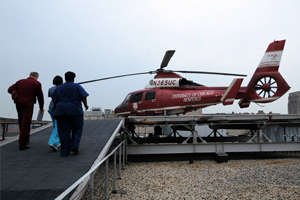Doctor copter
A writer takes a ride on the University�s Aeromedical Network helicopter.
By Benjamin Recchie, AB�03
Photography by Dan Dry

To the rescue: the aeromedical crew transports patients from around the region.
To the Federal Aviation Administration, it’s N365UC. To the University of Chicago Aeromedical Network (UCAN), it’s Aeromed One. And to the scores of College students whose discussions of Kant and Durkheim get interrupted by the whine of turbines and the chopping of helicopter blades, it’s Maroon Thunder. “We don’t really call it that,” said Ira Blumen, the program and medical director of UCAN for almost 23 years. Call it what you will: on a foggy March day, it was my goal to hitch a ride.
The University of Chicago Medical Center was the first Chicago-area institution to get an air medical-transport program, in 1983. The current helicopter, UCAN’s fourth, a sleek Eurocopter Dauphin, makes more than 500 flights a year. So when trying to schedule a ride-along, I figured any given day had good odds for a flight.
I arrived at the UCAN offices at 7 a.m. for a safety briefing from pilot Fred Ligman, who has been flying UCAN for 24 years and helicopters for almost 40. Ligman had strict rules for safety: Never walk under the tail boom. Don’t approach the helicopter if the rotors are turning unless the pilot motioned to me. Say “Go around!” into the intercom if I saw that the helicopter was trying to land on top of a pole or wire.
A typical run, explained Blumen, begins with a hospital or fire department seeking to send a patient to the Medical Center. If there’s space in the hospital—and there wasn’t much the day I was there—a nurse consults with the other agency to determine whether helicopter or ground ambulance is the best transportation mode, considering the travel time, weather, and the patient’s condition. “The only time we won’t try to move a patient,” Blumen said, “is if they’re trying to resuscitate them.” If there’s no space, the patient goes on a waiting list while doctors seek space elsewhere. Most helicopter flights remain in the Chicago metropolitan area, but the chopper has flown in patients from as far away as St. Louis and Michigan’s Upper Peninsula.
The helicopter’s speed is not its only advantage to patients, who pay for the transport as part of their hospital bill. Whereas an ambulance typically carries two paramedics, the helicopter carries a physician and a nurse, as well as more advanced life-support equipment. Despite the word “aeromedical” in the name, almost half of UCAN’s patient transports go by ground.
As it happened, heavy fog kept the flying ambulance grounded the morning I was there, and a shortage of space in the ICU kept it from flying all afternoon. I had been standing by for 11 hours when Community Hospital in Munster, Indiana, called with a transport request. A patient had what doctors initially thought was necrotizing pneumonia, but now they were uncertain; a large research hospital like the Medical Center could diagnose and treat him more effectively. A space had opened up in Chicago’s intensive-care unit, and the triage nurse said to fly him in.
Up on Mitchell Hospital’s rooftop helipad, the helicopter looked large at first glance, but it was a little tight on the inside. The crew and I wore crash helmets equipped with noise-canceling headsets that let us speak normally despite the racket from the engines and rotors. I could hear the pilot talking to air traffic control as Aeromed One, identifying our origin, destination, and fuel load, as well as “four souls on board.”
Lifting off was gentler than an elevator. Our flight from Hyde Park to Munster took only eight minutes; it almost took longer to walk from the helipad to the Indiana hospital’s ICU. The patient was intubated and only semiconscious; Community Hospital’s staff had sedated him to prevent him from deliriously tearing off the tubes and wires keeping him alive. The transport nurse and physician labored for half an hour to transfer the patient from the hospital’s life-support equipment to the helicopter’s—relatively fast work, the dispatchers told me. Then, accompanied by Ligman, a police officer to patrol the helipad, and me, they wheeled the patient out to the helicopter. The pilot restarted the engines, contacted air traffic control—“This is Aeromed One. Five souls on board.”—and again we were off.
Halfway back, someone broke the silence over the intercom: “This guy is a lot worse than they made him sound over the phone.” Perhaps I should have been nervous, sealed in an enclosed space with a man who had a possibly contagious disease, but I decided if our physician and nurse weren’t worried about it, then I wasn’t going to be, either.
Back at the U of C Medical Center, as the stretcher was moved from the helicopter to a gurney, there was no rushing or shouting like TV medical dramas portray—not that night, at least. (“Nothing is as dramatic as ER,” said Blumen, referring to the television show in which the University’s helicopter made cameos in the credits and in a handful of episodes.) The helicopter crew and hospital personnel worked quietly and efficiently to get the patient to the ICU. I took my leave of them there; my job was over, but theirs was just beginning.
Return to top
